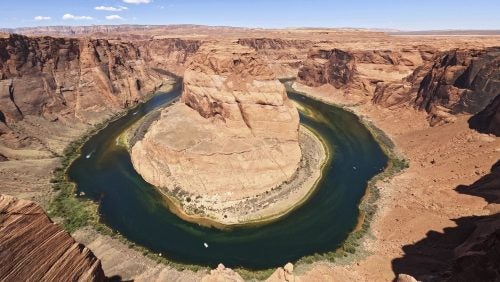Drought in the American West and Equitable Water Use
April 10, 2023 by Benjamin Wilken

Horseshoe Bend on a sunny day.
The American West is dry. Despite extreme weather events like the series of atmospheric rivers that doused the West Coast (from late 2022 until the time of this piece’s composition), capable of dumping up to half an inch of rain an hour,[1] the overall trend has been one of less reliable precipitation in a narrowing band of time during the year.[2] As climate change results in increased temperatures in the West, the historical cool season shrinks, leading to a more volatile and intense potential rainy season for states like California which rely on the cool-season atmospheric rivers for upwards of 50% of annual precipitation.[3] In the face of increasingly uncertain precipitation, vital reservoirs like Lake Mead and Lake Powell have reached record low levels and have even approached “dead pool status” with insufficient water in the reservoirs to allow power generation facilities to continue to operate.[4]
Although there are implications for hydroelectric power generation as a result of emptying reservoirs, states are simultaneously battling increasing water demand from both growing populations and agricultural operations.[5] Agriculture consumes nearly 80% of the water in the Colorado River Basin and crops like alfalfa demand half of that water alone.[6] Additionally, the federal government continues to subsidize other water-intensive crops such as cotton; cotton farmers are insured against price drops by the federal government and can receive advance loans before a crop is harvested, contributing to a cotton industry where the market might not otherwise allow.[7]
Adding to the problem of immense agricultural demand from California is the inequity between states’ rights to water: water districts in California possess senior rights, while states like Arizona and Nevada receive lesser, junior entitlements and will bear the first burden of water restrictions. [8] As of February 2023, the Colorado River states of Colorado, Wyoming, New Mexico, Utah, California, Arizona, and Nevada have failed to agree to a plan for decreased consumption, and the issue of a reduction agreement has now fallen within the federal purview. [9]
Absent from the negotiations between states were the Native American tribes of the area, 14 of which requested that the Department of the Interior allow representation during negotiations.[10] [11] The racial groups that benefited from the water infrastructure boom of the 1930s are generally the same groups benefiting today, costing the United States $8.58 billion every year due to inequitable access and leaving Native Americans, Black Americans, and other communities of color with an inherited infrastructure disadvantage.[12] However, there is hope for creating new access to water for historically underserved communities, as the Bipartisan Infrastructure Law (BIL) earmarks $700 million to improve water source availability and connection infrastructure with grants for individuals with low or moderate income, and an additional $250 million for the Indian Reservation Drinking Water Program.[13] The BIL’s passage was relatively recent, so time will tell if the designated federal money goes to serving, particularly Native American Tribes in the West reliant on the Colorado River.
[1] Matthew Cppucci, A Truly ‘Brutal System’: Atmospheric River to Slam California The Washington Post (Jan. 3, 2023), https://www.washingtonpost.com/weather/2023/01/03/california-west-coast-atmospheric-river/.
[2] Alexander Gershunov et al., Precipitation Regime Change in Western North America: The Role of Atmospheric Rivers, Nature: Scientific Reports (July 9, 2019), https://www.nature.com/articles/s41598-019-46169-w.
[3] Id.
[4] As The Climate Dries The American West Faces Power and Water Shortages,Experts Warn, UNEP, https://www.unep.org/news-and-stories/story/climate-dries-american-west-faces-power-and-water-shortages-experts-warn (last visited March 17, 2023).
[5] Id.
[6] Jessica Fu, It’s The Thirstiest Crop in the US South-West. Will The Drought Put Alfalfa Farmers Out of Business? The Guardian (Sept. 12, 2022), https://www.theguardian.com/environment/2022/sep/12/colorado-drought-water-alfalfa-farmers-conservation.
[7] Abraham Lustgarten & Naveena Sadasivam, ProPublica, How Federal Dollars Are Financing the Water Crisis in the West, Scientific American (May 27, 2015), https://www.scientificamerican.com/article/federal-dollars-are-financing-the-water-crisis-in-the-west/.
[8] Lara Korte, The Southwest Is Bone Dry. Now, a Key Water Source Is at Risk, Politico (Jul. 6, 2022), https://www.politico.com/news/2022/07/06/colorado-river-drought-california-arizona-00044121.
[9] William Brangham, Western states that rely on Colorado River fail to reach agreement
on cutting consumption, PBS NewsHour (Feb. 3, 2023), https://www.pbs.org/newshour/show/western-states-that-rely-on-colorado-river-fail-to-reach-agreement-on-cutting-consumption.
[10] Id.
[11] Living Without Water is Draining Us: New report released on economic impacts of water access
Inequity, Southwest Environmental Finance Center (July 28, 2022), https://swefc.unm.edu/home/living-without-water-is-draining-us-new-report-released-on-economic-impacts-of-water-access-inequity/.
[12] Id.
[13] Aaron Bielenber et al., The US Bipartisan Infrastructure Law: Reinvesting in Water, McKinsey (Feb. 17, 2022), https://www.mckinsey.com/industries/public-and-social-sector/our-insights/the-us-bipartisan-infrastructure-law-reinvesting-in-water.

